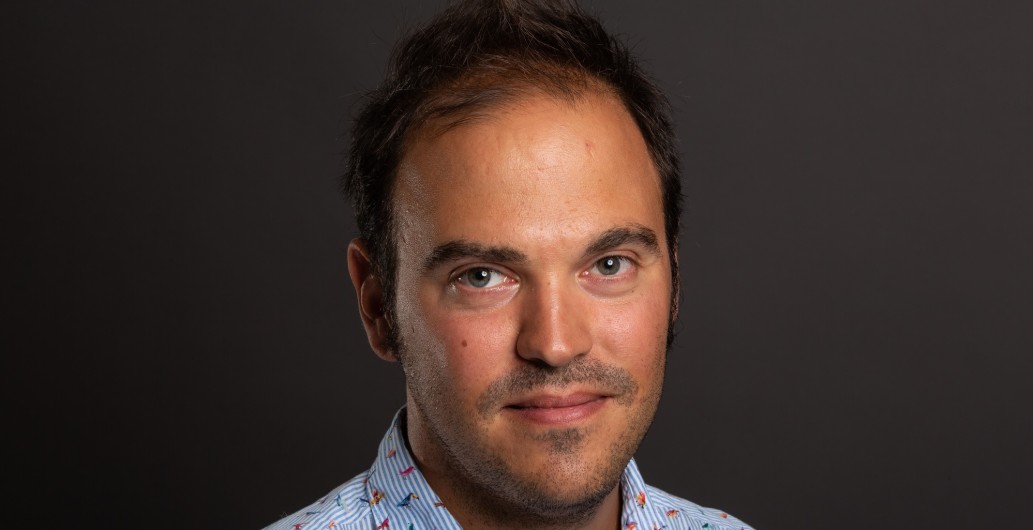Landry Bretheau, winner of the 2020 Nicholas Kurti Science Prize

Sketch of a one-atom Josephson junction (up left), an Andreev reflexion (bottom left) and a Schrödinger cat synthetized by quantum Zeno dynamics (right).
Each year, Oxford Instruments awards the Nicholas Kurti Science Prize, which promotes promising young European scientists working in the fields of low temperatures and/or high magnetic fields. In 2020, this prize is jointly awarded to a researcher from the Research Center of the Institut Polytechnique de Paris, Landry Bretheau, assistant professor at the Laboratory of Condensed Matter Physics (PMC*), and to Rebeca Ribeiro-Palau, CNRS researcher at the Centre de Nanosciences et de Nanotechnologies from Paris-Saclay University.
Portrait of Landry Bretheau - a young researcher with an outstanding career
Landry Bretheau graduated from École Polytechnique (X2005), where he specialized in quantum and condensed matter physics. This strong academic training enabled him to carry out a Ph.D. in the Quantronics Group of the CEA Saclay, under the supervision of Hugues Pothier and Cristian Urbina. There he realized unprecedented experiments in the field of mesoscopic superconductivity. By measuring microscopic excitations in atomic-size structures (one billionth of a meter), Landry demonstrated experimentally the existence of "the Andreev bound states", quantum electronic states at the origin of the Josephson effect in superconductors. This discovery was published in the prestigious scientific journal Nature in 2013 and was rewarded by the École Polytechnique Thesis Award.
Landry’s discoveries continued during two successive postdocs at ENS and MIT. At ENS, in the group of Benjamin Huard, he made several experiments with superconducting circuits to probe the influence of measurement on elementary quantum systems. In particular, he demonstrated the quantum dynamics of light under the Zeno effect, a phenomenon predicted 15 years earlier and that offers a new method of controlling quantum systems. At MIT, in the group of Pablo Jarillo-Herrero, the young researcher explored the physics of two-dimensional materials, such as graphene, in which quantum physics plays a key role. His work has enabled him to make major contributions in these research fields, with the publication of remarkable articles in Science, Physical Review Letters (PRL) and Nature Physics.
Since 2017, Landry Bretheau has joined the École Polytechnique to build up a new research group with his colleague Jean-Damien Pillet. This group, called Quantum Circuits & Matter (QCMX), aims to explore the quantum properties of hybrid systems based on low-dimensional conductors and superconducting circuits.. To develop this new activity, he was awarded a Young Team Fellowship from École Polytechnique and a Young Researcher Grant from the French National Research Agency (ANR JCJC).
“What motivates my research is to explore the beauty and weirdness of quantum physics by probing superconducting circuits at low temperature”. While still at an early stage in his career, this young researcher has already explored very diverse fields and made major contributions to each of them. Honored by the Nicholas Kurti Europe Prize, he wanted to associate the researchers with whom he has worked in recent years.
*PMC: a joint research unit CNRS, École Polytechnique - Institut Polytechnique de Paris
Learning more
Discover the publications of Landry Bretheau that have had the most impact:
[1] Evidence for Long-Lived Quasiparticles Trapped in Superconducting Point Contacts,
PRL 106, 257003 (2011), M. Zgirski, L. Bretheau, Q. Le Masne, H. Pothier, D. Esteve, & C. Urbina
[2] Exciting Andreev pairs in a superconducting atomic contact,
Nature 499, 312-315 (2013), L. Bretheau, Ç.Ö. Girit, H. Pothier, D. Esteve & C. Urbina
[3] Supercurrent Spectroscopy of Andreev States,
PRX 3, 041034 (2013), L. Bretheau, Ç.Ö. Girit, C. Urbina, D. Esteve & H. Pothier
[4] Coherent manipulation of Andreev states in superconducting atomic contacts,
Science 349, 1199-1202 (2015), C. Janvier, L. Tosi, L. Bretheau, […], & C. Urbina
[5] Observing Interferences between Past and Future Quantum States,
PRL 112, 180402 (2014), P. Campagne-Ibarcq, L. Bretheau, E. Flurin, A. Auffèves, F. Mallet & B. Huard
[6] Quantum dynamics of an electromagnetic mode that cannot have N photons,
Science 348, 776-779 (2015), L. Bretheau, P. Campagne-Ibarcq, E. Flurin, F. Mallet & B. Huard
[7] Observing Quantum State Diffusion by Heterodyne Detection of Fluorescence,
PRX 6, 011002 (2016), P. Campagne-Ibarcq, P. Six, L. Bretheau, […], & B. Huard
[8] Observing a quantum Maxwell demon at work
PNAS 114, 7561-7564 (2017), N. Cottet, S. Jezouin, L. Bretheau, […], & B. Huard
[9] Tunnelling Spectroscopy of Andreev States in Graphene,
Nature Physics 13, 756-760 (2017), L. Bretheau, J. I-J. Wang, […], & P. Jarillo-Herrero
[10] Electrically tunable low-density superconductivity in a monolayer topological insulator
Science 362, 926-929 (2018), V. Fatemi, S. Wu, Y. Cao, L. Bretheau, […], R. J. Cava, & P. Jarillo-Herrero
Nature Nano 14, 120-125 (2019), J. I-J. Wang, D. Rodan-Legrain, L. Bretheau, […], & W. D. Oliver
 Support l'X
Support l'X